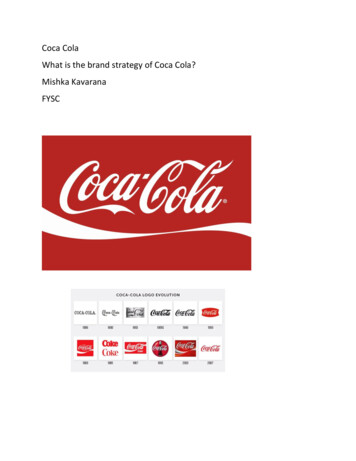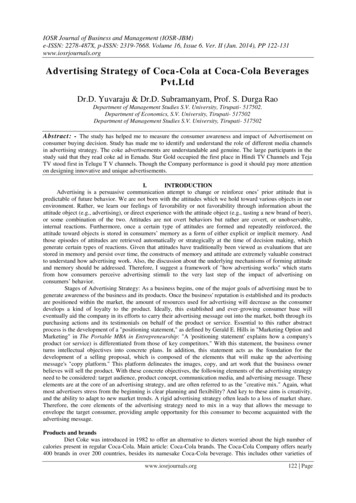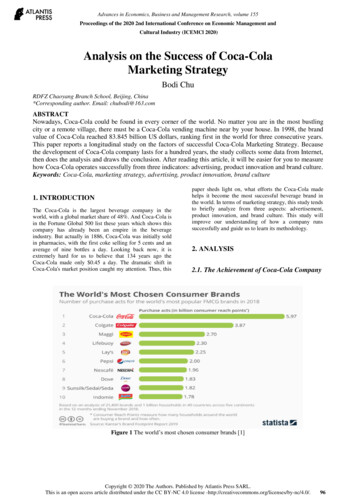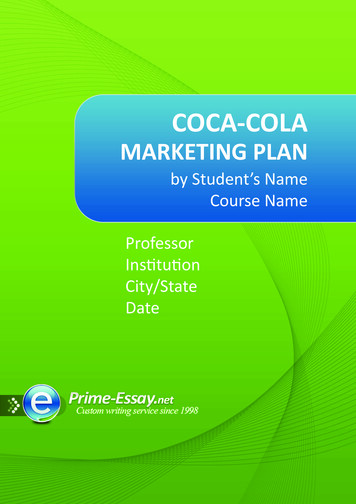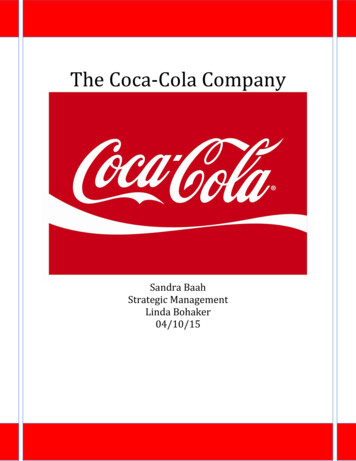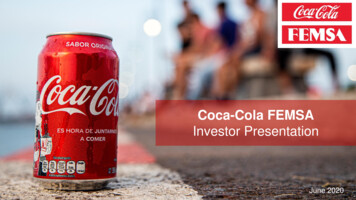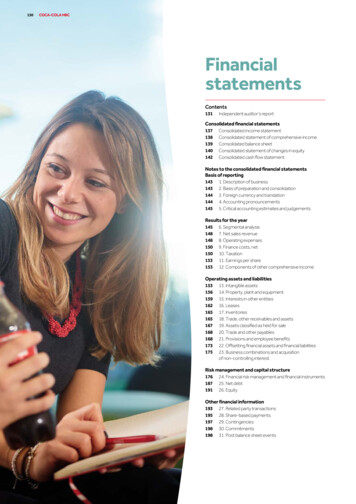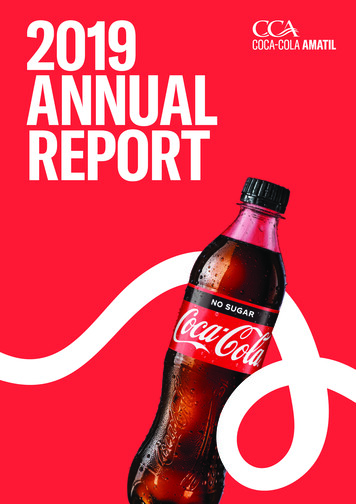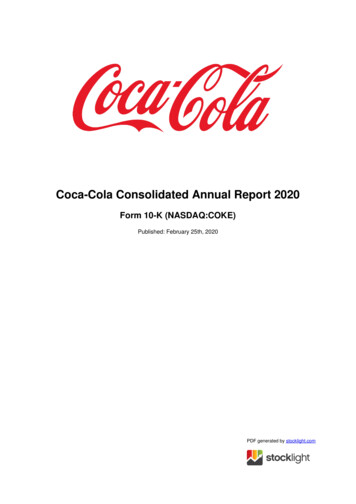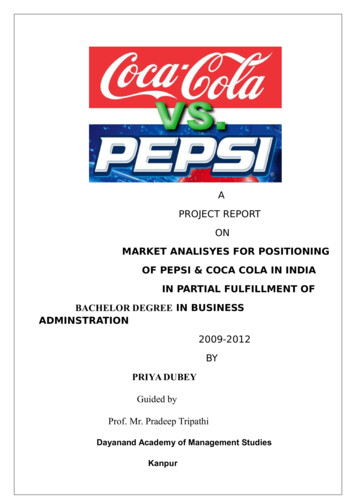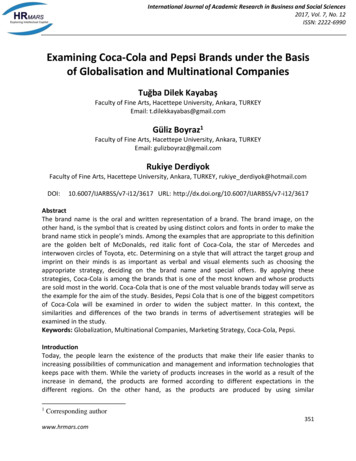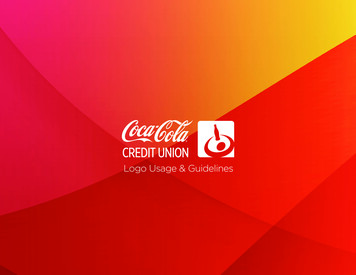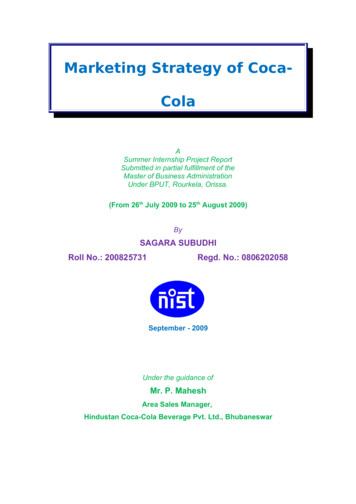
Transcription
Marketing Strategy of CocaColaASummer Internship Project ReportSubmitted in partial fulfillment of theMaster of Business AdministrationUnder BPUT, Rourkela, Orissa.(From 26th July 2009 to 25th August 2009)BySAGARA SUBUDHIRoll No.: 200825731Regd. No.: 0806202058September - 2009Under the guidance ofMr. P. MaheshArea Sales Manager,Hindustan Coca-Cola Beverage Pvt. Ltd., Bhubaneswar
NIST Business SchoolPalur Hills, Berhampur-761008, Orissa, India
ACKNOWLEDGEMENTI would like to take this opportunity to thank all those individuals whose invaluablecontribution in a direct or indirect manner has gone into the making of this project atremendous learning experience for me.I express my deep sense of gratitude to Mr. Sapan Patnaik, Sales Manager,Bhubaneswar & Berhampur for having been a constant source of encouragementsand also for his valuable support in each and every aspect of this project.I would like to thank Mr. P. Mahesh, Area Sales Manager, Hindustan Coca-ColaBeverage Pvt. Ltd., Bhubaneswar, Orissa for giving me the opportunity to work inHCCBPL. I would also like to thank for being the constant source of information andgiving his valuable time and guidance throughout the project.My heartiest thanks to Mr. Prabhat Satapathy and Mahesh Patnaik, SalesExecutive, Berhampur for their help and cooperation for doing my project easily andsuccessfully.Finally I thank the authors of all those books and manuals we have referred in thecourse of preparation of this project. I also express my heartily thanks to my parents,friends and all those people who are related to this project at any stage of its making,for their readiness to help me out whenever required.Sagara Subudhi
LIST OF TABLESTable 2.1 No. of Bottles in Case in different Packs.24Table 2.2 Classification of Outlets on the basis of Volume.29
LIST OF FIGURESFigure 2.1 Dr. John Stith Pemberton.14Figure 2.2 Brand Ambassadors of Coca-Cola .17Figure 2.3 Brands under PepsiCo .19Figure 2.4 Brands under Parle Agro.19Figure 2.5 Brands under Dabur.19Figure 2.6 Brand Portfolio of Coca-cola .21Figure 2.7 Segmentation Model.29Figure 2.8 Brand Order System of Coca-Cola.31Figure 2.9 Promotion Strategies .33Figure 2.10 Flow of Distribution System.35Figure 4.1 Percentage of Outlets Area - 1.55Figure 4.2 Percentage of Channels of Outlet of Area – 1.56Figure 4.3 Percentage of Chilling Equipments of Area - 1.56Figure 4.4 Percentage of Size of SGA of Area - 1.57Figure 4.5 Percentage of Glass Strength of Area - 1.57Figure 4.6 Percentage of Outlets Area - 2.58Figure 4.7 Percentage of Channels of Outlet of Area – 2.59Figure 4.8 Percentage of Chilling Equipments of Area - 2.59Figure 4.9 Percentage of Size of SGA of Area - 2.60Figure 4.10 Percentage of Glass Strength of Area - 2.60Figure 4.11 Percentage of Outlets Area - 3.61Figure 4.12 Percentage of Channels of Outlet of Area – 3.62Figure 4.13 Percentage of Chilling Equipments of Area - 3.62Figure 4.14 Percentage of Size of SGA of Area - 3.63Figure 4.15 Percentage of Glass Strength of Area - 3.63Figure 4.16 Percentage of Outlets Area - 4.64Figure 4.17 Percentage of Channels of Outlet of Area – 4.65Figure 4.18 Percentage of Chilling Equipments of Area - 4.65Figure 4.19 Percentage of Size of SGA of Area - 4.66Figure 4.20 Percentage of Glass Strength of Area - 4.66
Figure 4.21 Percentage of Outlets Area - 5.67Figure 4.22 Percentage of Channels of Outlet of Area – 5.68Figure 4.23 Percentage of Chilling Equipments of Area - 5.68Figure 4.24 Percentage of Size of SGA of Area - 5.69Figure 4.25 Percentage of Glass Strength of Area - 5.69Figure 4.26 Percentage of Outlets Area - 6.70Figure 4.27 Percentage of Channels of Outlet of Area – 6.71Figure 4.28 Percentage of Chilling Equipments of Area - 6.71Figure 4.29 Percentage of Size of SGA of Area - 6.72Figure 4.30 Percentage of Glass Strength of Area - 6.72
TABLE OF CONTENTSACKNOWLEDGEMENT.3LIST OF TABLES.4LIST OF FIGURES.5TABLE OF CONTENTS.71. INTRODUCTION.91.1 General Overview of Indian Industry .91.2 Purpose of the Study.121.3 Scope of the Study.131.4 Objective of the Study.132. COMPANY PROFILE.142.1 History of the Coca Cola Company.142.2 Mission of Coca Cola .162.3 Vision of Coca-Cola.162.4 Brands Tagline.172.5 Brand Ambassadors.172.6 SGA Providing Companies.172.7 Competitive Environment.182.8 Brand Portfolio of Coca-Cola India.202.9 Manufacturing Unit of HCCBPL.242.10 Packaging Details.252.11 Variables.262.12 Research for Marketing Strategy.262.13 Market Segmentation Model of Coca-Cola.282.14 Brand Order System of Coca-Cola.302.15 Sales Promotion Strategies of Coca-Cola.312.15.1 Introduction.312.15.2 Forms of Sales Promotion .312.15.3 Methods of Sales Promotion.322.15.4 Promotion Strategies.332.16 Channel Management.342.17 Distribution System of Products in Market.342.18 Market Allocation of Coca-Cola.35
2.19 Target Core.352.20 Market Execution (Activation) Standards of Coca-Cola.352.21 SWOT Analysis of HCCBPL.472.21.1 Strengths.472.21.2 Weaknesses.482.21.3 Opportunities.482.21.4 Threats.482.22 Push & Pull Strategy.483. METHODOLOGY.503.1 Design of the Study.503.2 Data Collection Source and Methods.503.3 Sampling Details.503.4 Field Work Details .513.4.1 Route Visit.513.4.2 EDS Survey.523.5 Limitations.534. FINDINGS AND INTERPRETATION.544.1 Findings.544.2 Interpretation.555. CONCLUSION & RECOMMENDATIONS.735.1 Conclusion.735.2 Recommendations .73REFERENCES .75APPENDIX – SURVEY REPORT.76
MARKETING STRATEGY OF1. INTRODUCTION1.1 General Overview of Indian IndustryThe Fast Moving Consumer Goods (FMCG), also known as Consumer PackagedGoods are those products that have a quick turnover and relatively low cost.Consumers generally put less thought into the purchase of FMCG than they do forother products. Items in this category include all consumables (other than groceries /pulses) people buy at regular intervals. The most common in the list are toilet soaps,detergents, shampoos, toothpaste, shaving products, shoe polish, packaged foodstuff,and household accessories and extends to certain electronic goods. These items aremeant for daily of frequent consumption and have a high return. A major portion ofthe monthly budget of each household is reserved for FMCGT products. The volumeof money circulated in the economy against FMCG products is very high, as thenumber of products the consumer use is very high. Competition in the FMCT sectoris very high resulting in high pressure on margins.The Indian FMCG sector is the fourth largest sector in the economy with a totalmarket size in excess of US 13.1 billion. It has a strong MNC presence and ischaracterized by a well established distribution network, intense competition betweenthe organized and unorganized segments and low operational cost. FMCG Sector isexpected to grow by over 60% by 2010. That will translate into an annual growth of10% over a 5-year period. It has been estimated that FMCG sector will rise fromaround Rs. 56,500 crores in 2005 to Rs. 92,100 crores in 2010. Though the sectorwitnessed a slower growth in 2002-2004, it has been able to make a fine recoverysince then.Burgeoning Indian population, particularly the middle
Atlanta-based Coca-Cola Company is one of the first global majors to have spotted the potential spin-offs from the country’s rural markets. It has perfected a unique supply chain to cater to India’s vast rural hinterland. The results are working, and Coca-Cola India’s rural penetration increased from 13 percent in 2001 to 25 percent
